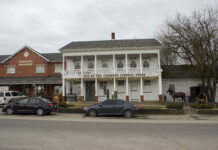During the 1940s and 1950s, people moved about as they had never moved before. World War II, the wartime prosperity, the automobile, new job opportunities, and an urge to see what lay beyond the ridge, were all causes of folks wandering. This movement resulted in changes in the character of the country and its people.
Nothing new
Foul water, filthy air, stifling congestion, deadly epidemics, street crime, moral degeneration, and poverty did not suddenly materialize in American cities after World War II or at any given moment. They have been a part of the urban scene since the dawn of the Republic.
Those who long for the days of Washington, Lincoln and Roosevelt, the “Rough Rider,” when the nation’s cities were supposedly safe, clean, well-ordered communities, unknowingly look back upon places that were filled with Jerry-built fire traps.
Not idyllic
It was a place where periodic epidemics of cholera and yellow fever claimed sizeable portions of the people, where fear of the violence caused people to stay indoors after dark, where the atmosphere was so polluted that lights were ignited in midafternoon, where citizens gambled with their health when they drank the water, and where thousands of horses made public thoroughfares little more than open sewers.
Since before the Declaration of Independence, bossism, corruption, overcrowding and vice have existed in American cities. Nevertheless, the city always has been the economic, social and intellectual engine of the nation and the rise of urban areas is an index of overall national prosperity.
Just as the halfway point in the 20th century did not witness the birth of urban problems, neither did this period see the first moves to that increasingly nebulous area called suburbia. Attempts to combine “wholesome rurality” with the tensions and turmoil of city living date back to the early 1820s.
Suburbia grows
But urban problems, as well as assets, did increase quantitatively as the American city swelled to gargantuan dimensions after World War II. Great technological advances during the war, prosperity, automobile, new opportunities, G.I. Bill, federal housing authority and other influences boosted the population of suburbia and caused people to move about as never before.
The postwar population explosion was of paramount importance to this movement. Between 1950 and 1955, United States metropolitan areas grew by 12,000,000 persons, while the number of people living within the central cities increased by only 2,400,000.
Following the building boom of the Roaring ’20s and the shift of thousands of American families to new residences away from the inner-city, the Great Depression and World War II brought suburbanization to a screeching halt.
Moving out
With the return to peace and war profits in our pockets, there rose a cry for more and better housing everywhere. Utilizing the latest building techniques, contractors assembled fields of dwelling units adjacent to established cities. Because of the high price of property and the heavy density of persons living on it, most planners, developers and sub dividers of the 1950s concluded that it was more profitable to turn to vacant land outside the cities to build new housing.
Project with such sylvan names as Edgewood Acres, Green Belt, Beechwood, Forest Hills, and Mission Valley were built across the country. A new era of lifestyle had opened and suburbia appeared to be the best solution to the nation’s housing problem.
New lifestyle
Distance from the central city with its jobs, entertainment, and other attractions was not very important, after all, everyone had a car or two. Within a short period of time suburban life gave birth to a new lifestyle in the United States foreign to the rest of the world.
The hours commuting meant that there was less time to devote to the family. The cleavage between the place he lived in and the place he worked in meant at best divided loyalty.
While the population of the suburbs increased that of the city often went down. Moreover, the city’s loss to its satellite “edge communities” appeared to be mainly people from the higher economic level, younger and more vigorous groups.
Alienating?
Critics assailed all this as dehumanizing and sterile. They said it alienated people from their fellow kinsmen, made housewives neurotic, and created a climate in which people sank deeply into debt in order to surround themselves with an array of idol consumer goods.
Logical substitutes
Supporters pointed to the new residential areas cleanliness, better schools and churches, and the nearness to nature. While there were many tawdry “look-alike” neighborhoods in the suburbs, not all consisted of identical streets lined with shoe box houses and anemic looking saplings. Elite suburbs such as Cleveland’s Shaker Heights and Kansas City’s Overland Park were logical substitutes for the quality neighborhoods and mansions of the old city.
However, “bedroom neighborhoods” like Levitts Town in Pennsylvania, where homeowners slept on week nights and battled crab grass on Saturdays, became the most common destination of those who migrated from the older cities.
Bettering themselves
Once they had purchased their home and actually made the move, the new suburbanites felt that they had bettered themselves. Their visits to the old neighborhood became less and less frequent and their attitudes tended to become more sophisticated concerning politics, economics, religious and ethnic matters.
All in all, suburbia gave the white American wage earner a cleaner, newer, and fresher start, and generally a higher quality place to live than he had ever before enjoyed. That’s your history!












